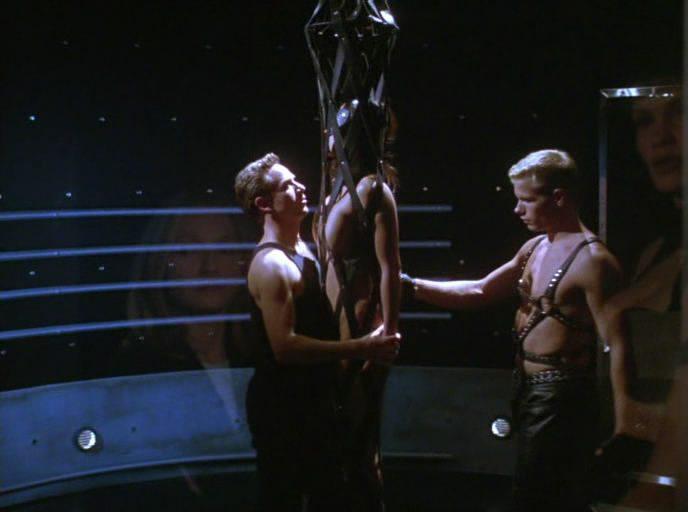Mercy (2000) (IMDB) is a late entry in the erotic thriller genre that dominated in the 80s and 90s. This kind of movie was getting stale by the turn of the millennium, and many scenes seem strongly reminiscent of Body Double (previously discussed) and Se7en.
It starts, as usual for this kind of film, with a dead body. This time it’s a nude woman, one of a series with signs of being tied up, bite marks all over her torso, and her eyelids cut off. Detective Catherine Palmer (Ellen Barkin) forms a relationship with Vickie (Peta Wilson), a friend (and likely more) of the victim, Dorothy.
Palmer searches the victim’s home and finds a hidden briefcase full of BDSM toys, and pictures of the victim being dominated by a masked man. She calls up a pro dominatrix via Vice and visits her dungeon in an upscale building.
Palmer: “And what’s your area of expertise, Terry?”
Dominatrix: “Japanese silk ropes and the finer psychological aspects of the relationship between the players. I can tie you so you can’t twitch your ass cheeks. Of course it’s time consuming. It’ll cost you a couple of grand. Mostly the businessmen like that.”
The dominatrix shows a hidden room where she can observe people play, such as a woman being dominated by her husband and another man. She shows webcam photos of the victim and Vickie going to the dungeon together. (Nothing from inside the dungeon, though.) I’m not sure a pro dominatrix would so readily hand over client information to the police, but being an informant may be the price she has to pay for the police to turn a blind eye to her business.
Vickie introduces Palmer to an elite club of women who gather for private parties. Some just chat, others move to the cuddle (and more) room in the back.
Vickie: “There’s a worm inside me. Men tend to bring it out. But not women.”
This is not entirely true, as we later see Vickie submitting to both men and women.

Palmer realizes that the murder victims were all in this group, but still thinks that a man did the killings.
Palmer “[The key to the case is] Pain, and people who don’t like their sex without it. I think that’s the door that lets men into this group.”
Vickie is the mysterious femme fatale who challenges Palmer, the detective. Is she the killer or a potential victim? And will Palmer act on the sexual attraction that grows between them?
Vickie: “Do you know what I think sex is?”
Palmer: “What?”
Vickie: “A thrill. It’s like putting your head in the mouth of the only lion in the cage that’s totally unpredictable.”
[…]
Vickie: “Aren’t you just a little bit curious?”
Palmer: “What do you want to do? Take me to one of your dungeons?”
Vickie: “You’d be amazed at the use we can get out of simple kitchen utensils.”
However, Vickie’s sexuality defies categorization. She’s enmeshed in this implicitly lesbian subculture, and involved with men too. (Also, she smokes crystal meth.)

In one sequence, Palmer follows Vickie to a motel and witnesses her playing out an elaborate Vietnam war sniper fantasy with one male suspect. The very blond and blue-eyed Vickie puts on a black wig and a latex Chinese dress (wrong country, but whatever), gives herself epicanthic eye folds with clear tape, and dances suggestively at a window while the guy watches her from another building through a sniper rifle’s scope. Somehow they time it so the fake blood pack explodes at just the right moment. Later, we find out that he is a retired USMC sniper who keeps a collection of photos of dead Vietnamese men.
Typically for this kind of thriller, there are a lot of red herrings and false suspects, such as the therapist, Dr. Broussard, who is having affairs with his clients and is a crossdresser. (At least Mercy avoids the cliche of the transvestite murderer of women, preferring the cliche of the transvestite murder victim.)
None of the male suspects work out, and Palmer proposes to her male colleagues that what they’re looking for is a female killer. Everybody scoffs at this, as the profilers all say that female killers are rare and only kill in their homes or in one location. Palmer continues her investigation, looking into Vickie and the world of closeted, upper-class lesbians.
Mercy attempts to apply feminist and queer critique to the erotic thriller genre. It proposes an underground network of relations between women, largely out of sight of men but still influenced by them. These bonds are strong and not always positive, enough to lead to repeated murders.
Many of the characters talk about sexual abuse from fathers and stepfathers. It suggests the old trope of lesbianism resulting from women having bad experiences with men. Things get a little more complicated in the therapy sessions, in which the women talk about their conflicted feelings about their mothers, who were to some degree complicit in their daughters’ abuse. This is the tangled web that Palmer uncovers and eventually follows to the killer.
What Mercy keeps circling back to is women betraying each other to survive against patriarchal violence. The relationships between women are often triangulated off men. Vickie admits to Palmer that not only was she sexually abused by her father and brothers, when she ran away, she left her little sister in her place. Palmer still bears a grudge against the woman who had an affair with her ex-husband. When Palmer and the woman meet by chance, the movie briefly shifts into Palmer’s fantasy of punching her out. In reality, it’s just an awkward moment. (It also shows Palmer displacing her anger onto the other woman instead of her husband.) Mary is deeply conflicted about her own mother, for refusing to acknowledge the step-father’s molestation of her daughter even as it happened right in front of her. In other words, Mary’s murders can ultimately be traced back to feelings of betrayal by her mother, the prototype for all women.
The film’s final plot twist is that Broussard’s female persona is enough to make him(?) a target of the killer. Instead of transference of the patient’s feelings towards the father to the therapist, it’s the feelings towards the mother that are transferred to the female-presenting therapist. This echoes Cruising (previously discussed) with its killer (or one of them) haunted by his dead, disapproving father. Here, the killer is haunted by her treacherous mother and projects her onto other people.
Mercy doesn’t go very deep into kink; it’s just one of the many non-normative sexualities displayed, along with lesbianism, infidelity, non-consensual voyeurism, and crossdressing.
Palmer’s detective partner: “Doesn’t anybody still get off on just good old normal sex anymore? Missionary position, then you watch TV afterwards?”
It also suggests it all comes back to childhood trauma. It’s uncomfortably close to old views of sexual deviance stemming from bad childhood experiences.
Mercy isn’t a success, but it’s an interesting failure.






You often bring to my attention films I have never heard of before. Thank you for telling us all about this one.